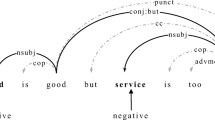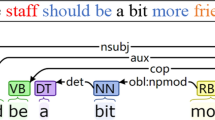Abstract
Fine-grained sentiment analysis is currently a main focus in the field of natural language processing. In line with the significance of the semantics and the syntax, both semantic- and syntactic-based approaches are dedicatedly devised and developed. However, the highly integrating of the semantic and syntactic information is still challenging, which leads to the misinterpretation of the sentence. In this work, we propose a human cognition-based method for aspect-based sentiment analysis (ABSA), which establishes the learning from word semantics to sentence syntax. A dual-channel semantic learning graph convolutional networks (GCNs) is devised to capture both the general semantics and the structural semantics of words. Subsequently, a syntactic GCN for sentence syntactic structure learning is carried out. As such, the understanding of the given sentence is performed in line with the human processing practice. Our model is evaluated on five public datasets on the tasks of ABSA. Experimental results reveal that the proposed model is a competitive alternative comparing to the state-of-the-arts methods.








Similar content being viewed by others
Notes
The source code is accessible below: https://github.com/snowblue2/DSS-GCN.
References
Li, H., Xue, Y., Zhao, H., Hu, X., Peng, S.: Co-attention Networks for Aspect-level Sentiment Analysis, pp. 200–209. Springer, Berlin (2019)
Kim, S.-M. & Hovy, E. Determining the sentiment of opinions. In: COLING 2004: Proceedings of the 20th International Conference on Computational Linguistics, pp. 1367–1373 (2004)
Wang, Y., Huang, M., Zhu, X., Zhao, L.: Attention-based LSTM for aspect-level sentiment classification. In: Proceedings of the 2016 conference on empirical methods in natural language processing, pp. 606–615 (2016)
Tay, Y., Tuan, L. A., Hui, S. C.: Learning to attend via word-aspect associative fusion for aspect-based sentiment analysis. In: Thirty-Second AAAI Conference on Artificial Intelligence (2018)
Sun, K., Zhang, R., Mensah, S., Mao, Y., Liu, X.: Aspect-level sentiment analysis via convolution over dependency tree. In: Proceedings of the 2019 Conference on Empirical Methods in Natural Language Processing and the 9th International Joint Conference on Natural Language Processing (EMNLP–IJCNLP), pp. 5679–5688 (2019)
Zhang, C., Li, Q., Song, D.: Aspect-based sentiment classification with aspect-specific graph convolutional networks. In: Proceedings of the 2019 Conference on Empirical Methods in Natural Language Processing and the 9th International Joint Conference on Natural Language Processing (EMNLP–IJCNLP), pp. 4560–4570 (2019)
Saffran, J.R.: Statistical language learning: mechanisms and constraints. Current Dir. Psychol. Sci. 12(4), 110–114 (2003)
Levin, B.: English Verb. Classes and Alternations: A Preliminary Investigation. University of Chicago press, Chicago (1993)
Brooke, J.: A semantic approach to automated text sentiment analysis. Ph.D. thesis, Department of Linguistics-Simon Fraser University (2009)
Nelson, K.: Concept, word, and sentence: interrelations in acquisition and development. Psychol. Rev. 81(4), 267 (1974)
Kreidler, C.: Introducing English Semantics. Routledge, London (2002)
Chen, Z., Ren, J.: Short text embedding for clustering based on word and topic semantic information, 61–70 (IEEE, 2019)
Van Valin, R.D., van Valin Jr, R.D., van Valin Jr, R.D., LaPolla, R.J., LaPolla, R.J.: Syntax: Structure, Meaning, and Function. Cambridge University Press, Cambridge (1997)
Chen, P., Sun, Z., Bing, L., Yang, W.: Recurrent attention network on memory for aspect sentiment analysis. In: Proceedings of the 2017 conference on empirical methods in natural language processing, pp. 452–461 (2017)
Dong, L., Wei, F., Tan, C., Tang, D., Zhou, M., Xu, K.: Adaptive recursive neural network for target-dependent twitter sentiment classification. In: Proceedings of the 52nd annual meeting of the association for computational linguistics (volume 2: Short papers), pp. 49–54 (2014)
He, R., Lee, W. S., Ng, H. T., Dahlmeier, D.: Effective attention modeling for aspect-level sentiment classification, 1121–1131 (2018)
Kipf, T. N., Welling, M.: Semi-supervised classification with graph convolutional networks. ICLR 2017 (2017)
Zhang, Y.-D., Satapathy, S.C., Guttery, D.S., Górriz, J.M., Wang, S.-H.: Improved breast cancer classification through combining graph convolutional network and convolutional neural network. Inf. Process. Manag. 58(2), 102439 (2021)
Wang, S.-H., Govindaraj, V., Gorriz, J. M., Zhang, X., Zhang, Y.-D.: Explainable diagnosis of secondary pulmonary tuberculosis by graph rank-based average pooling neural network. J. Ambient Intell. Humanized Comput. 1–14 (2021)
Marcheggiani, D., Titov, I.: Encoding sentences with graph convolutional networks for semantic role labeling, 1506–1515 (2017)
Bastings, J., Titov, I., Aziz, W., Marcheggiani, D., Sima’an, K.: Graph convolutional encoders for syntax-aware neural machine translation, 1957–1967 (2017)
Yao, L., Mao, C., Luo, Y.: Graph convolutional networks for text classification 33, 7370–7377 (2019)
Liang, B., Yin, R., Gui, L., Du, J. & Xu, R. Jointly learning aspect-focused and inter-aspect relations with graph convolutional networks for aspect sentiment analysis, 150–161 (2020)
Zhang, M., Qian, T.: Convolution over hierarchical syntactic and lexical graphs for aspect level sentiment analysis, 3540–3549 (2020)
Wang, K., Shen, W., Yang, Y., Quan, X., Wang, R.: Relational graph attention network for aspect-based sentiment analysis, 3229–3238 (2020)
Vaswani, A., Shazeer, N., Parmar, N., Uszkoreit, J., Jones, L., Gomez, A.N., Kaiser, Ł., Polosukhin, I.: Attention is all you need. In: Advances in neural information processing systems, pp. 5998–6008 (2017)
Tang, H., Ji, D., Li, C., Zhou, Q.: Dependency graph enhanced dual-transformer structure for aspect-based sentiment classification, 6578–6588 (2020)
Lang, E., Maienborn, C.: Two-level semantics: Semantic form and conceptual structure. Edited by Claudia Maienborn Klaus von Heusinger 114 (2011)
Pennington, J., Socher, R., Manning, C. D.: Glove: Global vectors for word representation, 1532–1543 (2014)
Maas, A. et al. Learning word vectors for sentiment analysis, 142–150 (2011)
Mikolov, T., Chen, K., Corrado, G., Dean, J.: Efficient estimation of word representations in vector space. arXiv preprint arXiv:1301.3781 (2013)
Wang, R., Fu, B., Fu, G., Wang, M.: In: Deep and cross network for ad click predictions, 1–7 (2017)
Pontiki, M. et al. SemEval-2014 task 4: Aspect based sentiment analysis, 27–35 (Association for Computational Linguistics, Dublin, Ireland, 2014). https://www.aclweb.org/anthology/S14-2004
Pontiki, M., Galanis, D., Papageorgiou, H., Manandhar, S. & Androutsopoulos, I. Semeval-2015 task 12: Aspect based sentiment analysis, 486–495 (2015)
Pontiki, M. et al. Semeval-2016 task 5: Aspect based sentiment analysis, 19–30 (2016)
Zheng, Y., Zhang, R., Mensah, S., Mao, Y.: Replicate, walk, and stop on syntax. Effective Neural Netw. Model Aspect-level Sentiment Classif 34, 9685–9692 (2020)
Acknowledgements
This work was supported by the National Statistical Science Research Project of China under Grant No. 2016LY98, the Characteristic Innovation Projects of Guangdong Colleges and Universities (Nos. 2018KTSCX049) and the Science and Technology Plan Project of Guangzhou under Grant Nos. 202102080258 and 201903010013.
Author information
Authors and Affiliations
Corresponding authors
Additional information
Publisher's Note
Springer Nature remains neutral with regard to jurisdictional claims in published maps and institutional affiliations.
Rights and permissions
About this article
Cite this article
Dai, A., Hu, X., Nie, J. et al. Learning from word semantics to sentence syntax by graph convolutional networks for aspect-based sentiment analysis. Int J Data Sci Anal 14, 17–26 (2022). https://doi.org/10.1007/s41060-022-00315-2
Received:
Accepted:
Published:
Issue Date:
DOI: https://doi.org/10.1007/s41060-022-00315-2




